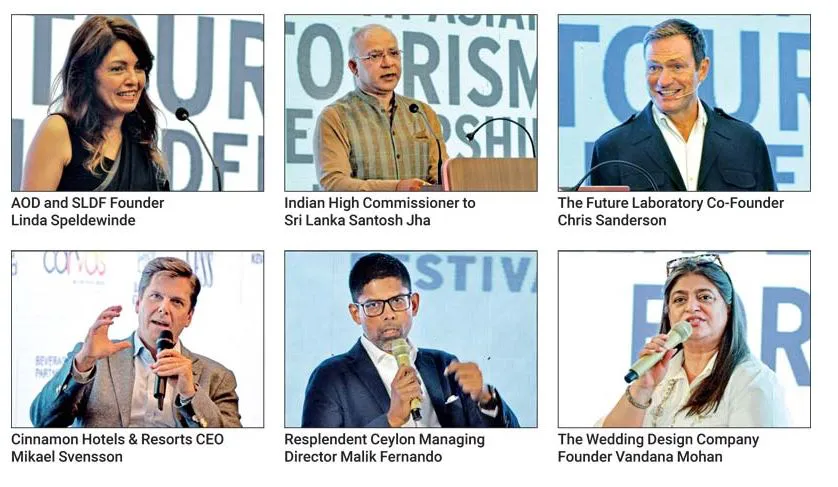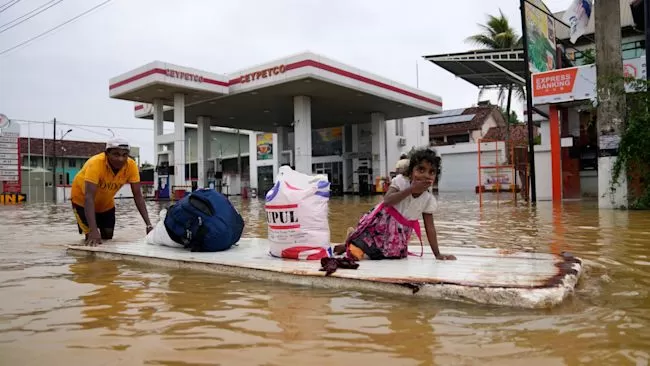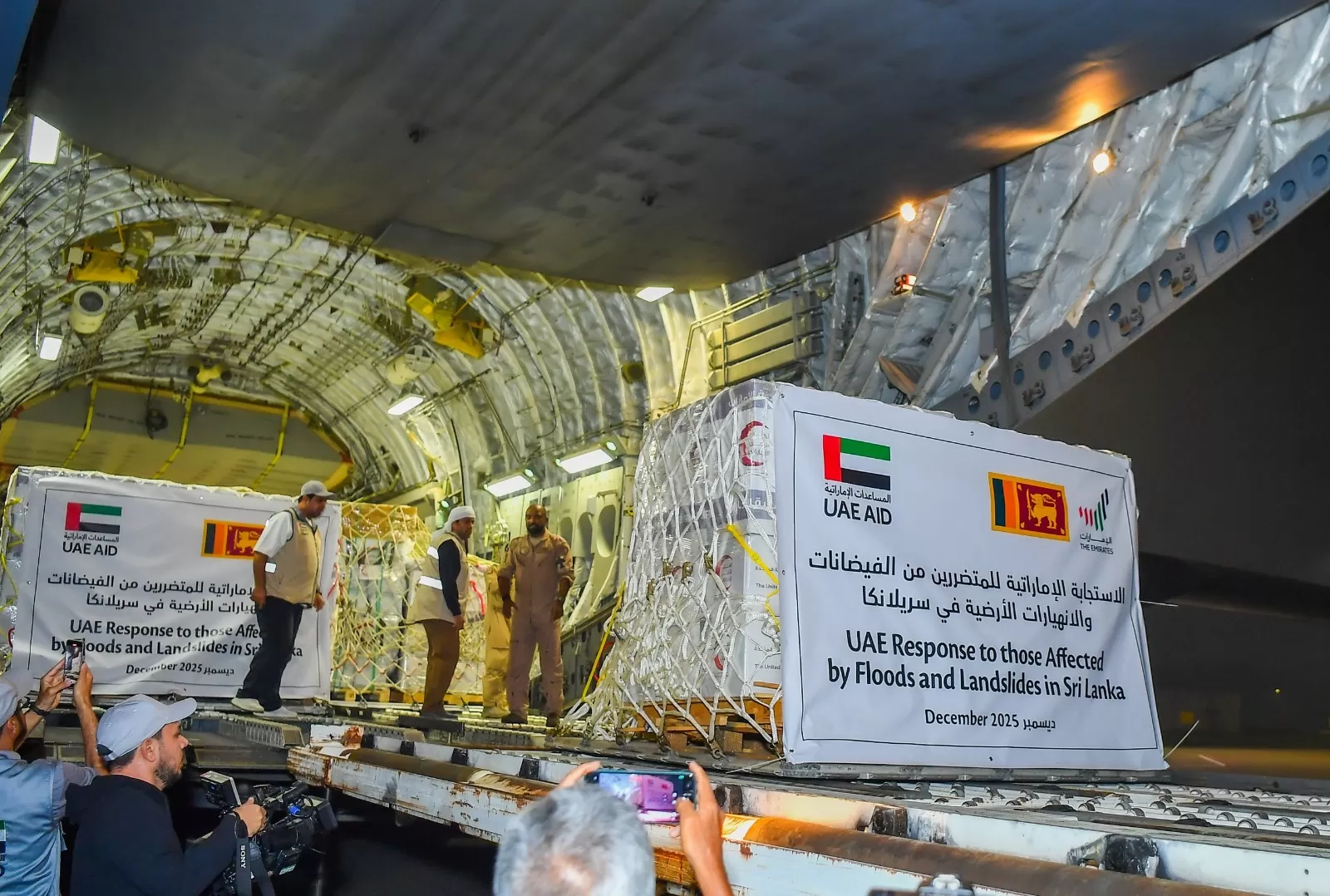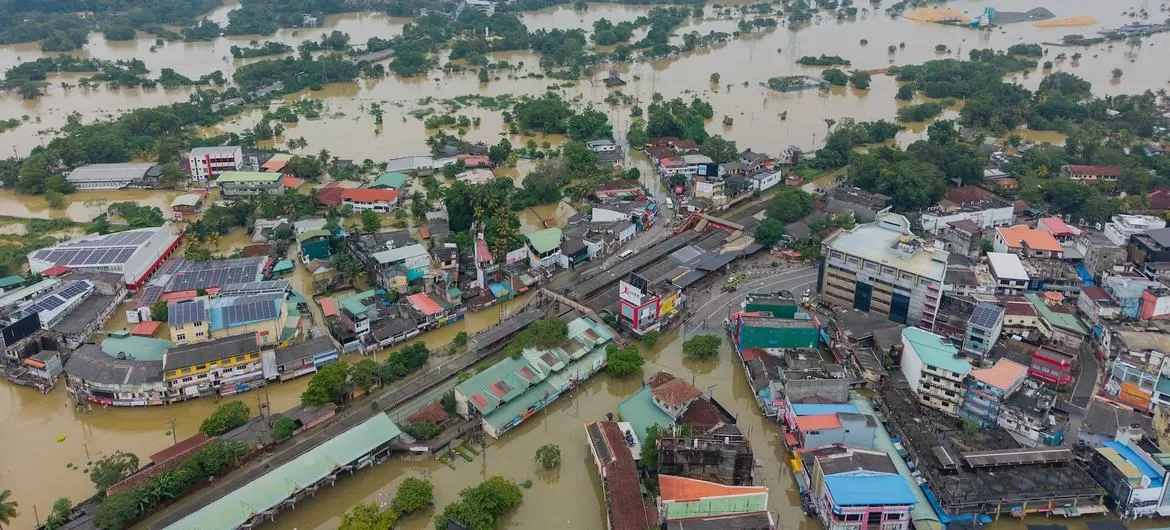
By Charumini de Silva
Sri Lanka’s tourism potential was spotlighted at the first ever South Asian Tourism Leadership Forum of Sri Lanka Design Festival 2024 last week.
Titled “Designing Experiences: Enhancing Sri Lanka’s Luxury Travel Offer”, the forum focused on Sri Lanka’s potential to secure its place on the map through a unique blend of authenticity and high-end offerings as global luxury travel evolved toward curated experiences over mere opulence.
Global industry experts discussed how bespoke hospitality, and immersive cultural experiences could position the island nation as a South Asia’s premier luxury destination.
Panellists including seasoned leaders and brand visionaries explored strategies to cater to niche markets, drawing design thinking to refine offerings that resonate deeply with travellers. Industry veterans, Steven Enderby and Rakhil Hirdaramani Co-Chaired the forum steering conversations on reimaging Sri Lanka’s appeal.
Design to elevate tourism industry
At the opening of the forum, AOD and SLDF Founder Linda Speldewinde shared her vision for how design thinking can elevate Sri Lanka’s tourism industry.
“We began with uplifting industries like apparel, and this year we are extending that focus to tourism. The South Asian Tourism Leadership Forum marks our first step,” she said, underscoring the forum’s goal of reimagining Sri Lanka as a destination defined by experiences rather than solely by accommodation.
With India as 2024/25 destination partner for SLDF, Speldewinde highlighted the support from a high-powered Indian delegation, stressing the collaborative approach to enhancing the region’s tourism appeal. She envisions Sri Lanka as an “incredible island with amazing experiences” – a place that first captivates with its culture and natural beauty before one even chooses where to stay. “I love my island nation,” she said.
Speldewinde shared passionately about her dream for Sri Lanka, an ideal where infrastructure and hospitality needs to be thoughtfully crafted around immersive experiences that celebrate the island’s unique character.
Boost India-Sri Lanka ties
Indian High Commissioner to Sri Lanka Santosh Jha was the Chief Guest of the forum, where he called for stronger tourism ties between the two countries. “In 2023, around 20% of the total visitors to Sri Lanka were from India,” he said, adding that this figure has room for significant growth as both countries deepen ties and expand connectivity.
The High Commissioner opined robust infrastructure, digital integration and targeted promotions could elevate Sri Lanka’s position as a premier destination for Indian travellers, while also enhancing local employment and foreign exchange earnings.
“Opportunity lies in tapping into the strong market of India,” the High Commissioner said, as the country is about to cross one million individuals with over $ 1 million.
Jha expressed confidence in expanding these numbers further, supported by both Governmental and private sector efforts to enhance infrastructure and connectivity.
Shaping Sri Lanka’s tourism future: Luxury, purpose, personalisation
In a compelling presentation, The Future Laboratory Co-Founder Chris Sanderson laid out a plan that holds potential for Sri Lanka’s tourism industry. He shared insights on shifting trends in luxury tourism and how destinations can cater to today’s traveller’s aspirations for deeper, purpose-driven experiences.
As Sri Lanka seeks to strengthen its position in the global tourism map, Sanderson’s ideas offer a fresh perspective on how the country can enhance its appeal, particularly in the high-end segment.
Sanderson emphasised that modern luxury is increasingly about experiences rather than possessions. Today’s travellers, particularly affluent ones, prefer to invest in meaningful, memorable moments over material goods. For Sri Lanka this trend signals a need to focus on creating transformative experiences that go beyond typical beach and historical site tours.
“Curating cultural exchanges, immersive nature retreats and sustainable wellness activities could attract the new-aged luxury travellers, who value experiences that resonate personally and culturally,” he pointed out.
Personalisation as core of hospitality, sustainable growth
Sanderson highlighted personalisation as a significant driver of customer satisfaction in luxury tourism, citing that nearly 60% of affluent travellers prioritise bespoke services tailored to their needs. This focus on customisation could serve Sri Lanka by offering exclusive and intimate itineraries that accommodate guests’ specific interests, such as unique cultural festivals or private exploration of historical landmarks. Building a network of personalised experiences would also allow Sri Lanka to capture loyalty among repeat high-end travellers.
With global awareness of climate change on the rise, Sanderson stressed the need for responsible tourism practices. His vision includes a future where air travel is regulated to limit environmental impact, a trend that could soon influence tourism policies worldwide.
In the Sri Lankan context, focusing on sustainable tourism can serve dual purposes — protecting its natural resources, while appealing to eco-conscious travellers. Initiatives like eco-friendly resorts, carbon offset options and sustainable transportation within the country could create a model for eco-luxury tourism that satisfies both tourists’ desires and environmental standards.
Building purpose-driven travel, avoid overtourism
Beyond mere relaxation, Sanderson noted that many travellers today are driven by the desire to make a meaningful impact. “Sri Lanka has a unique opportunity to position itself as a destination, where visitors can engage in “purposeful patronage” contributing to the local economy and communities they visit,” he pointed out.
Programs that invite tourists to participate in local conservation projects or support local artisans directly could amplify Sri Lanka’s allure, making the country a place for not just leisure, but also positive impact.
A startling statistic Sanderson presented is that, 80% of global tourists flock to only 10% of the world’s destinations. This, he said, presents an opportunity for Sri Lanka to draw visitors beyond traditional hotspots, spreading economic benefits across lesser-known but equally captivating regions. Highlighting places like Jaffna, Eastern Coast could showcase Sri Lanka’s diversity and alleviate pressure on popular areas, providing visitors with unique experiences, while preserving the integrity of high-traffic sites.
Creating a cohesive luxury brand
Sanderson underscored the importance of brand loyalty in luxury tourism. “Establishing a cohesive brand identity for Sri Lanka that appeals to luxury travellers could amplify its global reputation,” he said, suggesting that collaborating with hotel brands and creating luxury itineraries like exclusive or cultural wellness retreats — could make Sri Lanka a sought-after destination among affluent tourists, who often seek trusted recognisable brands in their travel choices.
Curating the Sri Lankan experience, perfecting the offer
During a panel discussion between Cinnamon Hotels & Resorts CEO Mikael Svensson and Resplendent Ceylon Managing Director Malik Fernando they outlined actionable strategies to reshape the sector’s experiences and offerings. The session was moderated by Shamindra Kulamannage.
Addressing challenges from authenticity to infrastructure, the duo emphasised the urgent need for targeted development to draw high-end visitors and boost the industry.
Central to Sri Lanka’s appeal, both Svensson and Fernando agreed is its authenticity — a unique quality that remains largely untapped and unspoiled.
Svensson stressed the importance of maintaining the authenticity as tourist numbers grow. “Sri Lanka has culture, heritage and tradition, elements that cannot be replicated. Our growth should not dilute this,” he stated, warning against the trend to commercialise heritage sites and experiences to cater to tourists.
Promotion of “slow travel” and a unified tourism strategy
Fernando echoed similar sentiments, advocating for “slow travel”, as an approach to preserve local traditions and natural beauty. He suggested reimagining the typical tourist route, shifting from overcrowded attractions like Yala National Park to lesser-known destinations across the country’s largely untouched landscapes.
“There are areas with incredible bird life, trekking routes and water bodies and sports potential that remain relatively unknown,” he said, adding that Sri Lanka could be promoted as “unhurried, immersive experience”, akin to Bali 30 years ago.
Fernando also highlighted the need for a coherent multi-year tourism strategy, which he noted has been lacking in Sri Lanka. “The current product has developed organically without much planning,” he said, stressing the inconsistency in managing tourism resources and the lack of targeted marketing efforts.
Svensson agreed, adding that the sector’s long-term growth depends on public and private sector collaboration. “We need an approach — a single approach. If we, the private sector and the Government can align behind a unified strategy, the whole industry benefits,” he pointed out.
Both leaders acknowledged India’s highly successful tourism campaign “Incredible India”, as an example Sri Lanka emulates, suggesting that with better marketing, the island nation’s natural and cultural assets could lure more affluent and engaged travellers.
Boosting infrastructure and a sustainable tourism
They pointed out that improving infrastructure was another key factor, noting that the current tourism framework is hindered by inadequate transport and limited access to some areas, making it challenging for tourists to explore beyond Colombo and a few established regions.
However, Fernando warned that infrastructure improvements must align with sustainable practices, ensuring that expansion does not harm the country’s ecological diversity.
Svensson emphasised Sri Lanka’s inherent advantage in sustainable tourism.
“With a high proportion of boutique and eco-friendly properties, Sri Lanka already promotes low-impact tourism, especially in rural areas,” Fernando outlined.
The duo acknowledged that popular destinations like Sigiriya and Yala risk becoming overrun, underscoring the need for robust management practices to protect these sites.
Demand, positioning and pricing
Fernando pointed out that Sri Lanka has yet to establish itself among top-tier tourist destinations, despite having high-quality products that remain underpriced.
“If we don’t position it correctly, Sri Lanka is at risk of becoming a low-value destination,” he cautioned.
As Sri Lanka’s pricing remains significantly lower than comparable destinations, such as Greece or Italy, he advocated for targeted campaigns to attract higher-paying tourists, who are willing to spend more for luxury and unique experiences.
Addressing the challenge of weak demand, Svensson spoke about Cinnamon’s approach of leveraging Colombo as a gateway and marketing its properties within a broader Sri Lankan experience.
“Rather than promoting individual hotels, Cinnamon campaigns highlight the attractions and unique offering of each location — thus underscoring the importance of destination marketing,” he asserted.
Both leaders urged Sri Lanka’s tourism stakeholders to adopt a visionary, coordinated approach.
Fernando suggested that with effective marketing, smart infrastructure investments and policies to protect cultural authenticity, Sri Lanka could well achieve its potential as a premier travel destination.
“Sri Lanka – first. Once travellers understand why they should come here, all else will follow,” Svensson opined.
Crafting a new era through destination weddings
The Wedding Design Company Founder Vandana Mohan shared crucial insights in capturing the Indian destination wedding market to provide significant revenue streams for Sri Lanka. The session was moderated by John Keells Group Senior Vice President – Global Alliances and Partnerships, and John Keells Leisure Head of Corporate Affairs Dileep Mudadeniya.
Sri Lanka has long been celebrated for its pristine beach, cultural heritage and warm hospitality — but the opportunity to drive tourism and enhance the country’s appeal on a global stage may lie within the booming wedding tourism industry, especially given the size and the demand of the Indian market.
According to industry leaders,with over 10 million weddings celebrated annually in India, the industry ranks as the fourth largest and is worth an estimated $ 130 billion.
She highlighted how Sri Lanka with its proximity to India, idyllic landscapes, welcoming culture could strategically position itself as a premier wedding destination for Indian couples looking for unique and exotic locations.
The core of Sri Lanka’s appeal
Mohan underscored the natural advantages Sri Lanka already holds, such as its beaches, mountain trails and heritage sites. Having vitiated Sri Lanka multiple times to oversee weddings, Mohan described “happy welcoming” demeanour of the Sri Lankan people as a distinctive asset, complimenting the island’s inherent scenic beauty.
“You have it all,” she remarked, noting that key tourist areas like Colombo, Galle and Kandy are widely recognised, yet “many more hidden gems remain unknown to potential clients abroad.”
To bridge this gap, she suggested Sri Lanka to focus on comprehensive awareness campaigns.
India’s successful “Incredible India” campaign coined by ad maven Sunil Yavi, serves as a blueprint, offering potential inspiration for Sri Lanka to similarly highlight its attributes in the wedding and tourism sectors. A campaign that immerses potential clients in the possibilities of a Sri Lankan wedding could create intrigue and demand among Indian couples seeking unique venues and experiences.
Leveraging partnerships and streamlining access
For Sri Lanka, to rival wedding destinations like Goa, Dubai and Bali, Mohan emphasised the importance of accessible information.
She called for collaboration between hotels, tourism boards and local vendors to streamline logistical processes. Drawing on examples from Italy and Singapore, Mohan explained that countries with robust tourism infrastructures simplify the planning experience, making it easy for couples and wedding planners to navigate local requirements and offerings.
“Sri Lanka should also look at a one-stop platform or concierge service that could alleviate much of the complexity in securing venues, permits and local resources,” she said, suggesting forming niche forums, associations or apps where vendors and planners could connect directly to create a seamless experience for clients.
Pricing paradigm
Mohan warned against Sri Lanka undervaluing its services in a bid to attract foreign clients. “Don’t sell yourselves cheap,” she advised, emphasising that many Indian families — regardless of socioeconomic background, are willing to invest in a high-quality memorable experience.
With the destination wedding segment growing at an estimated 13% annually, mid income families are now saving specially for weddings that reflect individual tastes and offer curated experiences.
However, Sri Lanka’s success in capturing the market lies in defining a clear pricing strategy that balances affordability with prestige. Mohan observed that wealthy Indian clients are willing to increase their wedding budgets by as much as 50% for a more adventurous or exclusive experience, underscoring the potential of high-end experiences designed around Sri Lanka’s unique landscapes and culture.
Missed opportunity
The Indian wedding industry has increasingly embraced “pre-wedding” experiences such as group getaways, cruise parties and weekend excursions that create memorable lead-ups to the main event. Mohan pointed out that while other destinations like Bali and the Maldives have embraced this trend, Sri Lanka is yet to capitalise on these offerings.
By creating packages, centred on these experiences — from beach excursions to cultural immersions — Sri Lanka could add an additional dimension to the wedding market, making it a more versatile destination for extended celebrations.
Skilled hospitality and planners
According to Mohan, Sri Lanka’s hospitality industry has a reputation for excellence, but could do more to build professional wedding services within the country. With the right skills, training Sri Lankan wedding planners could establish themselves as competitive players in the global market, helping the county become synonymous with high-quality wedding services.
Professionalism, transparency and delivering on promises were cited as the key qualities Mohan urged the aspiring wedding planners to develop, as they play a crucial role in building trust with international clients.
Govt. role in creating wedding friendly policies
She highlighted the regulatory challenges facing event planners, such as the need for multiple permits for beach ceremonies or late-night receptions.
Mohan suggested that the Government could establish a more streamlined process, allowing planners to obtain the necessary approvals without unnecessary bureaucracy. By emulating India’s State-specific regulations which allow for localised permission process, Sri Lanka could create a more planner friendly environment, easing access and facilitating larger more complex events.




